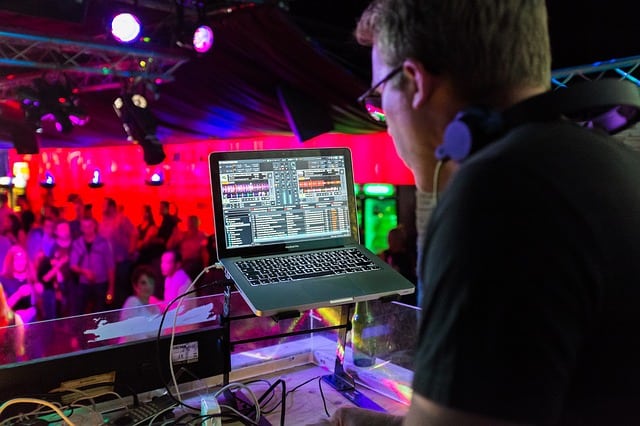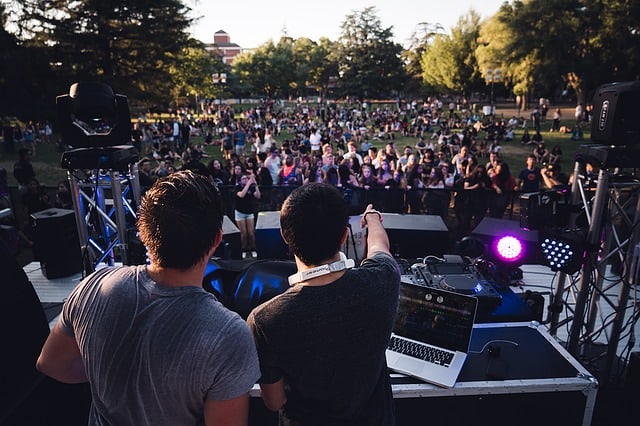Harmonic mixing (mixing in key) is a popular topic among many DJs. Many of those DJs think harmonic mixing is a must and others don’t believe in it. However, it is not that simple to only to choose to or not to harmonically mix your tracks (songs).
When to harmonically mix tracks as a DJ? We should harmonically mix to a track with an energy level we want and is harmonically mixable with our current track.
When not to harmonically mix tracks? We should not harmonically mix to a track with an energy level we don’t want. Because we should always prefer the tracks energy level above harmonic mixable.
In this post, I first give some minimal mixing basics. Then I explain the benefits of harmonic mixing and when not to mix tracks harmonically. After that, I provide some guidelines to when you should use harmonic mixing and that we can see harmonic mixing as a tool.
Mixing Basics
We can see the basics of mixing as two elements: the flow and the dance floor matrix.
- Flow (timing) – Timing has a lot to do with communicating with the dance floor and conveying a musical story. It is similar to a concert or exciting film which hold the attention of the audience by varying the energy levels. The quality of the presentation depends on the coherence between the tracks and the tracks themselves.
- The dance floor matrix – You get a good flow by having a solid organizational structure to your track collection. To be good at mixing tracks means that you have to be good at organizing songs based on groove, atmosphere, energy levels, and genre.
Why We Should Harmonic Mix
Harmonic mixing is critical when we need to perform longer mixes. It allows you to run your mixes for longer without losing any of the sweetness in between the tracks. Furthermore, harmonic mixing has two benefits:
- Win sonic result
- No musical key clashes

When Not to Harmonic Mix
Anticipating and reading the energy level of the crowd is probably your most important task as a DJ. To read the energy levels, you need to find tracks that connect with the momentum of the crowd. As such, you need to find the right moment and the right track that conforms to the energy level or else there is a risk for a potential energy drop for the crowd.
If you have a well-organized collection, then you have several options to choose from at any given moment. By default, the best option will be the one that is in key with the track currently playing. In practice though that may not be the best option given the energy of the crowd.
In such an instance, you may be better of going with another off-key track that matches the energy of the crowd. It is critical to remember that the music is a two-way conversation with the crowd and you that you don’t want to cut it off by playing a low energy track.
Sometimes a song that matches the energy level of the crowd may be planned several tracks away. If this is the case, then you have to play it immediately now to keep the energy going.
How to Decide When to Harmonic Mix or Not
Now we know two things that can help us to decide when we should harmonic mix and when we should. These two things are:
- Harmonic mixing is great for longer mixes and gives good sonic results without musical key clashes.
- Reacting to the energy level of the crowd is probably the most important task of a DJ.
There are four situations possible when we can decide to use harmonic mixing or not the use. The first two situations are:
- We want to keep or change the energy level of the music. Plus, we have a track with the energy level we want, which we can also use for harmonic mixing. This situation is probably obvious, we should mix to the track since we get the right energy level with the benefits of harmonic mixing.
- We want to keep or change the energy level of the music. However, we don’t have a track with the energy level we want, which we can also use for harmonic mixing. In this situation, we should prefer a track with the energy we want, since that is more important than harmonic mixing.
The other two situations can only happen to the not so good DJs since they describe situations by which we don’t mind the energy level of the music. These two situations are:
- We don’t mind the energy level of the music. Plus, we have a track which we can also use for harmonic mixing. This situation is probably also obvious, we should mix to the track since, in a way, we don’t have another choice.
- We don’t mind the energy level of the music. Also, we don’t have a track which we can also use for harmonic mixing. In this situation, you don’t have enough tracks.

Use Harmonic Mixing as a Tool
There is no perfect formula for mixing music, which will have the maximum impact that you expect on a crowd. However, it is important, and it can be very effective when we do it correctly. Nevertheless, you should use it just like the effects in the DJing software, the loops in the CDJ, or the EQ on the mixer.
Harmonic mixing is a good and effective tool in a DJs arsenal. However, it has been known to fall flat on its face if it is not matched with the energy levels of the crowd, and the genre of the music. Even the best DJs such as Armin van Buuren only use the tool.
Sometimes you may find that several tracks in your collection are grouped perfectly in a set of compatible keys. This makes it easy to do some harmonic mixing for longer performances. There is also software available that you could use that provide some inspiration to trying out a track that you else may not have played.
Moreover, harmonic mixing can make for some good practice sessions at home. They allow you to experiment with creative remixes and combinations.
However, finding a track in the longer sets that matches the key is rare. Thus, when you are playing to a live crowd finding the right song that matches the mood is more important.
Some Music Genres Are More Suited for Harmonic Mixing
Harmonic mixing is more suited to some types of music as compared to others. Some music that is more suited to harmonic mixing includes R&B, pop, and house music. Trance music would also work well with harmonic mixing since that it can have sustained pads and lush strings.
Genres with live drummers and strong structure such as rock do not work so well with harmonic mixing. On the other hand, playing familiar and already big tracks such as at a dance classics night will also work well with harmonic mixing.
Closing Words
If we can harmonically mixable to a track with the energy level we want, then we should do that. If we don’t have a track to which we harmonically mixable with the energy level we want, then we shouldn’t do that. However, it is good to remember that we can see harmonic mixing as a tool, and not as a perfect formula that we can always use.
If you like this post, then you may want to look at some posts in the Disc Jockey (DJ) part, since this post is also part of it.
Hopefully, you know now when and when not to use harmonic mixing. Also, when you know someone who likes to know more about when and when not to use harmonic mixing, then feel free to share this post. Additionally, do you have a tip about when and when not to use harmonic mixing?

